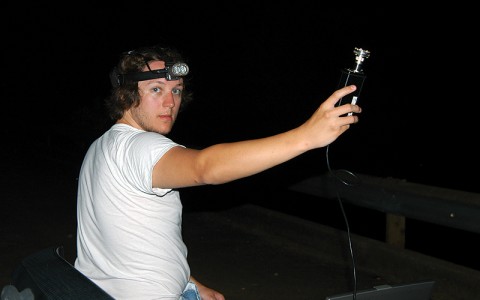 On a muggy summer night, while cicadas and crickets screeched in the woods at the Land Between The Lakes Recreational Area, a couple of Austin Peay State University graduate students attached a small microphone to the top of a van. Once it was set, they drove slowly through the wooded natural area, collecting sounds they couldn’t hear with the naked ear.
On a muggy summer night, while cicadas and crickets screeched in the woods at the Land Between The Lakes Recreational Area, a couple of Austin Peay State University graduate students attached a small microphone to the top of a van. Once it was set, they drove slowly through the wooded natural area, collecting sounds they couldn’t hear with the naked ear.
 “The microphone records bat calls – high frequency sounds we don’t hear generally,” graduate student Seth McCormick said. “It records and makes a document of it, so we’re able to see the pattern of each bat call. That way we can determine what species of bats are present.”
“The microphone records bat calls – high frequency sounds we don’t hear generally,” graduate student Seth McCormick said. “It records and makes a document of it, so we’re able to see the pattern of each bat call. That way we can determine what species of bats are present.”
McCormick and APSU grad student Morgan Kurz have made names for themselves within the scientific community in recent years because of their in-depth bat research. Their expertise led the U.S. Forest Service to contract with the APSU Center of Excellence in Field Biology this summer to monitor bat species in the 300-plus acre natural area.
“We’re only one of about eight universities nationwide that has a contract to do this kind of work,” Dr. Andy Barrass, associate professor of biology at APSU, said. “I’m real happy to have outstanding graduate students to do this work. “
The U.S. Forest Service contacted the school to conduct the survey because of fears that white nose syndrome might decimate the area’s rich bat population. For the last three years, the fungus disease known as white nose syndrome has led to the death of more than 1 million bats in the United States.
“Officials wanted to monitor what species of bats they have at LBL and create a kind of database in case white nose hits,” Kurz said. “That way, we’re able to see what kind of aftermath it has.”
The students arrived at the LBL natural area around 8:15 that July evening, just as the sun was setting, but with temperatures as high as 100 degrees during the day, the night sky offered little relief. McCormick and Kurz unloaded their equipment, attached the microphone to the roof of their van and then drove slowly through the forest in as straight a line as possible.
The microphone above emitted a light, flicking sound when it picked up a bat call. Occasionally, the students would turn down the sensitivity so the equipment wouldn’t record the crickets, frogs and cicadas so prevalent in the summer night.
“We also recorded at stationary points,” McCormick said. “We’d sit at each point for 10 minutes with two different types of microphones to see what types of bats were in that area.”

Later, back in the lab, McCormick jotted down notes from his evening in the woods. The research the students are conducting will likely be part of his graduate thesis. Aside from collecting bat calls, he’ll also be examining the reliability of the equipment they’re using. Currently, several states are buying “Anabat” monitors to collect bat calls.
“We’re going to try and do a comparison study of the different microphones,” he said. “States have been buying a lot of these Anabat units. I want to see if they are actually accurate, if they give the best data. I want to see if other microphones are picking up more bats than this one, or vice versa.”
The APSU students are also using very precise software in addition to the recommended Anabat units used by the U.S. Forest Service for the survey.
“Our evaluation software will allow us to differentiate not only the various species present, but between individual bats,” Barrass said.
McCormick also plans to set up nets in the natural area to catch bats. That way he’ll find out if the microphones are picking up as many bats as the nets capture.
“Hopefully we can do away with catching, and we can do a nonintrusive study with microphones,” he said. “Because it doesn’t hurt the bats with microphones. They don’t even know we’re there.”
For more information, contact the APSU Center of Excellence for Field Biology at 931-221-7019.


